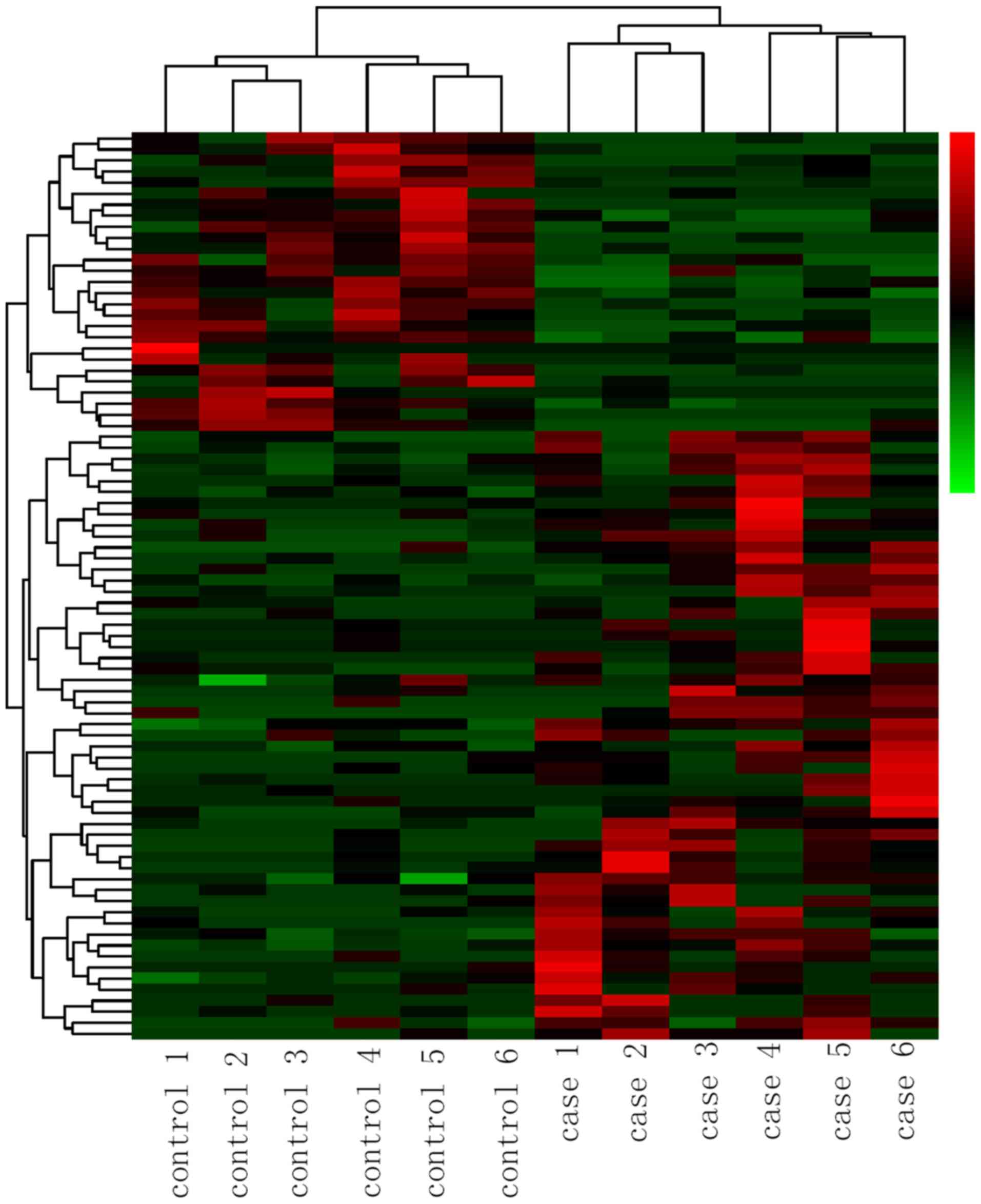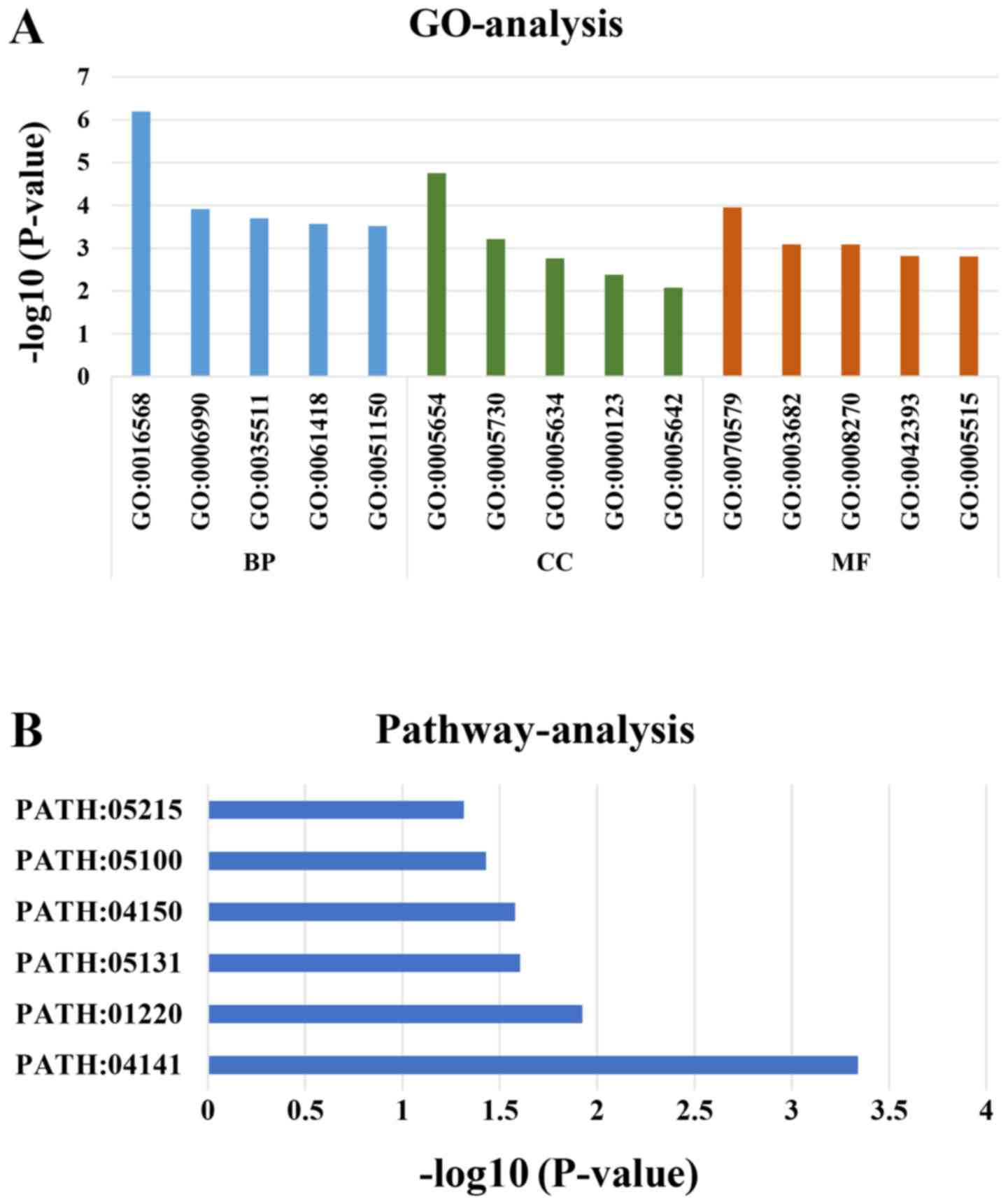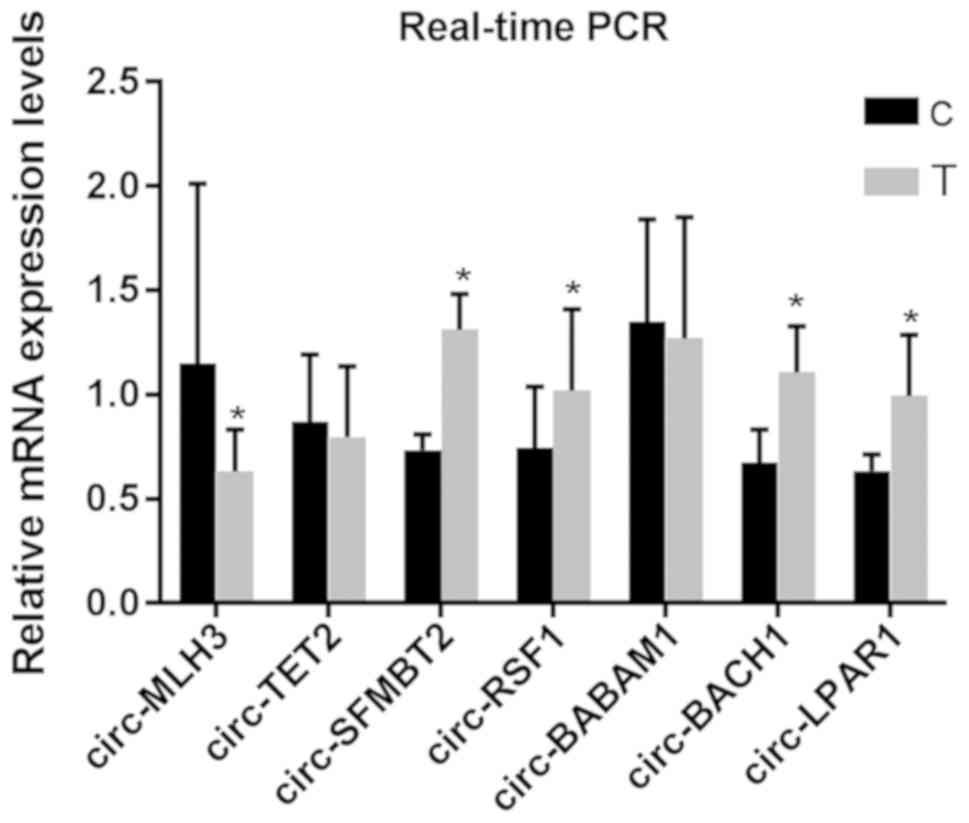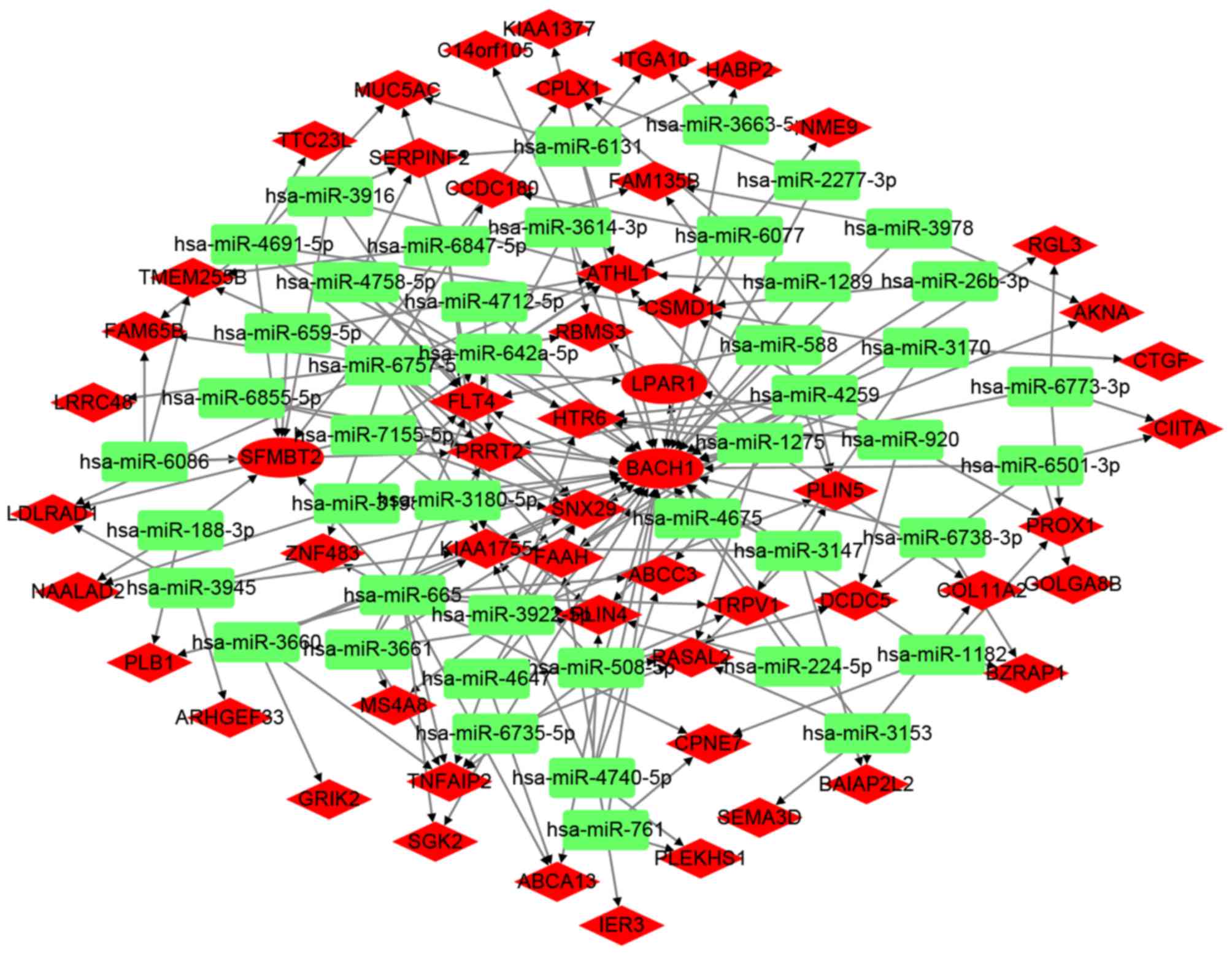Introduction
Currently, increasing families are facing
infertility problems. It has been estimated that 186 million people
are affected by infertility, imposing a heavy burden on both
families and society (1). With the
development of assisted reproductive technology (ART), especially
IVF-embryo transfer (IVF-ET), the pregnancy rate has significantly
increased during the past decades (2). However, there are still many factors
that lead to implantation failure.
To establish a successful implantation, a
developmentally competent embryo and a receptive endometrium are
both essential (3). Endometrial
receptivity (ER) changes with the menstrual cycle, and an embryo
can only be implanted during a short period of time called the
‘window’, when ER is appropriate for implantation (4). ER is a critical factor of gestation
and closely related to infertility. Lack of receptivity or an
embryo transfer that is not synchronized with a receptive
endometrium represents a major reason for implantation failure and
the subsequent failure of assisted reproduction (5).
Circular RNAs (circRNAs) are a class of non-coding
RNAs generated by back-splicing, forming a covalently closed loop
(6). They are widely expressed in
mammals, and many circRNAs have been identified (7). Recently, circRNAs were revealed to be
modulators in numerous physiological and pathological processes.
Specifically, circRNA-9119 was reported to regulate the development
of ER in dairy goat by sponging miR-26a (8). However, the role of circRNAs in human
infertility remains unclear and requires further investigation.
Acupuncture and moxibustion, which are important in
traditional Chinese medicine, have gained increased popularity for
treating infertility. A prevalence study that included eight
community and academic infertility practices in the United States
reported that 22% of their patients had tried acupuncture treatment
for infertility (9). Acupuncture
combined with embryo transfer can increase pregnancy and live birth
rates in women undergoing in vitro fertilization. The
pregnancy rate was 42.5% (34 out of 80 patients) in the acupuncture
treatment patients, while only 26.3% (21 of 80 patients) pregnancy
rate in patients without acupuncture (10). However, the molecular mechanism of
acupuncture in treating infertility has not been determined.
The aim of the present study was to verify that
acupuncture and moxibustion can be used to treat infertility by
altering the expression of circRNAs. CircRNA sequencing and reverse
transcription-quantitative (RT-q)PCR were conducted to examine
circRNA differences between patients treated with and those treated
without acupuncture and moxibustion. Then, the functions and
effects of circRNAs were analyzed by bioinformatics methods,
including Gene Ontology (GO) analysis and pathway analysis.
Materials and methods
Patients
From January 2016 to June 2017, 48 infertile women
of childbirth age treated at the Reproductive Medical Center of
Nanjing Jinling Hospital, were recruited into this study. These
women suffered from various diseases that lead to infertility and
were planning on receiving IVF-ET. To prepare the endometrium for
IVF-ET, the women were randomly assigned into two groups: One
received a regular endometrial preparation program and the other
received acupuncture and moxibustion in addition to the regular
endometrial preparation program, with 24 women in each group. All
women were monitored for the development of follicles by
transvaginal ultrasound. Endometrial samples were extracted on day
luteinizing hormone (LH) +7. Acupuncture was applied at the points
of guanyuan, zigong, zusanli, sanyinjiao, shenshu, and ciliao.
Acupuncture and moxibustion were administered starting the first
day of the two natural menstrual cycles before the in vitro
embryo transfer cycle up to the implantation day, one time on every
other day. Patients received acupuncture for 1 h at a time,
including half an hour on the front and half an hour on the back.
The clinical characteristics of the women in this study are
presented in Table I. The
follow-up data revealed that the pregnancy rate in the women
treated with acupuncture and moxibustion (58.33%) was higher than
that in the women who did not receive this treatment (41.67%). The
present study was approved by the Ethics Committee of Nanjing
Medical University (No. (2014)204). All women provided written
informed consent.
 | Table I.General characteristics of the
patients in this study. |
Table I.
General characteristics of the
patients in this study.
| Terms | Case group
(n=24) | Control group
(n=24) | P-value |
|---|
| Age, years | 32.75±0.40 | 31.46±0.84 | 0.17 |
| Infertility
years | 5.75±0.45 | 5.125±0.45 | 0.33 |
| BMI,
kg/m2 | 21.21±0.48 | 20.93±0.32 | 0.62 |
| Age of menarche,
years | 13.83±0.24 | 13.17±0.32 | 0.10 |
| Menstrual cycle,
days | 51.78±16.28 | 36.22 ±4.39 | 0.37 |
| Menstrual
duration | 5.67±0.44 | 5.56±0.53 | 0.87 |
RNA extraction, library construction,
and circRNA sequencing analysis
Six women in each group were used for circRNA
sequencing, and 24 women in each group were used for real time PCR.
Total RNA of endometrial samples from the case group and control
group were extracted using TRIzol (Invitrogen; Thermo Fisher
Scientific, Inc.), according to the manufacturer's instructions.
RNA quality and quantity were evaluated with a Nanodrop2000 (Thermo
Fisher Scientific, Inc.). Qualified RNA was processed for library
construction using a TruSeq Stranded mRNA sample preparation kit
and sequenced on a Hiseq™ 2500 platform (both from Illumina, Inc.)
with a paired-end 150 bp read run.
Bioinformatics analysis of sequencing
data
The FASTQ files generated by RNA sequencing were
aligned to the USCS hg38.0 Homo sapiens reference genome
with HISAT2 (11). The abundance
of gene expression was calculated using fragments per kilobase of
exon per million fragments mapped (FPKM). Differentially expressed
(DE) mRNAs and circRNAs were screened using the DeSeq package
(12) and EBSeq package (13) based on |log2 fold change
(FC)|>1 and a false discovery rate (FDR) <0.05. Functional
and pathway enrichment analyses for DEmRNAs and for the host genes
of DEcircRNAs were predicted using the DAVID and GO Consortium
platforms with a threshold of FDR <0.05.
miRNA prediction and construction of
the CeRNA network
The miRNA candidates that target the DEGs were
predicted using miRanda and RNAhybrid (14,15).
The predicted diameters were set to energy <-30 and score
>160 for miRanda prediction and energy <-30 for RNA hybrid
prediction. Only the overlapped miRNAs predicted by the two
databases were retained for further analysis. Cytoscape V3.0
(https://cytoscape.org) was used to construct the
CeRNA network.
RT-qPCR for validation of DEmRNAs and
DEcircRNAs
Total RNA of endometrial samples from 24 women in
each group were extracted using TRIzol. The concentration and
purity of RNA were assessed using a microspectrophotometer (Tiangen
Biotech Co., Ltd.). First-strand cDNA was synthesized using the
RevertAid First Strand cDNA synthesis kit (Thermo Fisher
Scientific, Inc.). FastStart Universal SYBR Green Master mix was
used to amplify cDNA on the QuantStudio 6 Flex Real-Time PCR System
(Thermo Fisher Scientific, Inc.). The primers are presented in
Table II. The 2−ΔΔCq
method was used to determine the relative gene expression with the
internal control of B2M (16).
 | Table II.The primers used for real-time
PCR. |
Table II.
The primers used for real-time
PCR.
| Name | Sequence |
|---|
|
circ-RP11-446H18.5-F |
5′-CCTGCCTTCCCTAGATATTGTCCT-3′ |
|
circ-RP11-446H18.5-R |
5′-TCCTAATCTAGCCTCTCCTGGG-3′ |
| circ-MIB1-F |
5-AGTATCCAAGTGGCAATAGGCA-3′ |
| circ-MIB1-R |
5′-TAGTAATTCGGTAAAAGCGATGTCT-3′ |
| circ-MLH3-F |
5′-TGAGGACATTCAGGCTGCTT-3′ |
| circ-MLH3-R |
5′-ATGGTAGGTAGAAAGATGGTGAGA-3′ |
| circ-TET2-F |
5′-TGTCAAGACTCAATATGATTTCCCA-3′ |
| circ-TET2-R |
5′-GGCAAATGGGAGGTGATGGT-3′ |
| circ-SFMBT2-F |
5′-AATCCCTTATTGATGCTGCCA-3′ |
| circ-SFMBT2-R |
5′-TCGAACCAGTCAAGTCACGTATG-3′ |
| circ-RSF1-F |
5′-AAGGAGGTCAACAAGAACAAGGA-3′ |
| circ-RSF1-R |
5′-CATCAGAGGAGGGCGAAGG-3′ |
| circ-BABAM1-F |
5′-AGATGAGTTGGAAGCCAGCAGA-3′ |
| circ-BABAM1-R |
5′-TCCGTCAAGGAGAACTGGGG-3′ |
| circ-BACH1-F |
5′-AATCAGAAATTGAGAAGCTGGTTG-3′ |
| circ-BACH1-R |
5′-GTTGTCGGGAAGTTCAGTGGA-3′ |
| circ-LPAR1-F |
5′-TGTAATTTCACAGCCCCAGGT-3′ |
| circ-LPAR1-R |
5′-CAGATCGAAGTCATGCTAGGAGA-3′ |
Statistical analysis
Real-time PCRs were repeated in triplicate. Data are
expressed as the mean ± standard deviation (SD) and compared using
Student's t test. P<0.05 was defined as the level of statistical
significance.
Results
Several circRNAs are differentially
expressed after acupuncture and moxibustion
Using high-throughput sequencing, 2,653 circRNAs
were identified, and 86 circRNAs were significantly differentially
expressed (|log2 FC|>1, FDR <0.05) between the acupuncture
group and the control group (Fig.
1). Moreover, among the DEcircRNAs, 57 circRNAs were
upregulated, and 29 were downregulated.
GO and pathway analysis of
differential circRNAs
The roles of circRNAs were investigated by GO
analysis within three different domains [biological process (BP),
cellular component (CC), and molecular function (MF)]. The top five
terms of each domain, ranked by -log10(P-value), are
presented in Fig. 2A and Table III. The identified BP terms were
chromatin modification, positive regulation of transcription from
RNA polymerase II promoter involved in unfolded protein response,
oxidative DNA demethylation, regulation of transcription from RNA
polymerase II promoter in response to hypoxia, and regulation of
smooth muscle cell differentiation. The identified CC terms were
nucleoplasm, nucleolus, nucleus, histone acetyltransferase complex,
and annulate lamellae. The identified MF terms were methylcytosine
dioxygenase activity, chromatin binding, zinc ion binding, histone
binding, and protein binding. The significantly enriched KEGG
pathways, ranked by -log10(P-value), are shown in
Fig. 2B and Table IV. The identified pathways were
protein processing in endoplasmic reticulum, degradation of
aromatic compounds, shigellosis, mTOR signaling pathway, bacterial
invasion of epithelial cells, and prostate cancer.
 | Table III.The top five (ranked by
-log10P-value) BP terms, CC terms, and MF terms. |
Table III.
The top five (ranked by
-log10P-value) BP terms, CC terms, and MF terms.
| GO ID |
-log10(P-value) | Description | GO terms |
|---|
| GO:0016568 | 6.1914023 | Chromatin
modification | BP |
| GO:0006990 | 3.9159859 | Positive regulation
of transcription from RNA polymerase II promoter involved in
unfolded protein response | BP |
| GO:0035511 | 3.6954187 | Oxidative DNA
demethylation | BP |
| GO:0061418 | 3.5660861 | Regulation of
transcription from RNA polymerase II promoter in response to
hypoxia | BP |
| GO:0051150 | 3.5206085 | Regulation of smooth
muscle cell differentiation | BP |
| GO:0005654 | 4.7545709 | Nucleoplasm | CC |
| GO:0005730 | 3.212923 | Nucleolus | CC |
| GO:0005634 | 2.7622145 | Nucleus | CC |
| GO:0000123 | 2.3794772 | Histone
acetyltransferase complex | CC |
| GO:0005642 | 2.0758729 | Annulate
lamellae | CC |
| GO:0070579 | 3.9552169 | Methylcytosine
dioxygenase activity | MF |
| GO:0003682 | 3.0894796 | Chromatin
binding | MF |
| GO:0008270 | 3.0872473 | Zinc ion
binding | MF |
| GO:0042393 | 2.8177814 | Histone
binding | MF |
| GO:0005515 | 2.8066047 | Protein
binding | MF |
 | Table IV.The significantly enriched KEGG
pathways [ranked by -log10(P-value)]. |
Table IV.
The significantly enriched KEGG
pathways [ranked by -log10(P-value)].
| PathwayID | -log10
(P-value) | Pathway term |
|---|
| PATH:04141 | 3.3411215 | Protein processing
in endoplasmic reticulum |
| PATH:01220 | 1.9245391 | Degradation of
aromatic compounds |
| PATH:05131 | 1.6033722 | Shigellosis |
| PATH:04150 | 1.5776843 | mTOR signaling
pathway |
| PATH:05100 | 1.4296001 | Bacterial invasion
of epithelial cells |
| PATH:05215 | 1.3156425 | Prostate
cancer |
circRNAs associated with infertility
are differentially expressed after acupuncture and moxibustion
Seven DEcircRNAs (circ-SFMBT2, circ-MLH3, circ-RSF1,
circ-BABAM1, circ-TET2, circ-BACH1, and circ-LPAR1) associated with
infertility were selected to verify the sequencing results by
RT-qPCR. The relative expression levels of the seven circRNAs are
presented in Fig. 3. The variation
tendencies of circ-SFMBT2, circ-MLH3, circ-RSF1, circ-BACH1, and
circ-LPAR1, but not those of circ-BABAM1 and circ-TET2, were in
accord with those observed in high-throughput sequencing. The
expression levels of circ-SFMBT2, circ-BACH1, circ-RSF1, and
circ-LPAR1 were significantly upregulated and that of circ-MLH3 was
downregulated in samples from patients treated with acupuncture and
moxibustion compared to levels in the control group.
Construction of the circRNA-miR-mRNA
interaction network
To evaluate the potential functions of the DE
circRNAs, upregulated circRNAs were selected, and a
circRNA-miR-mRNA interaction network was constructed (Fig. 4). circBACH1 was associated with 35
downregulated miRs, followed by circSFMBT2 with 7 downregulated
miRs and circLPAR1 with 3 downregulated miRs, indicating that
circBACH1 may play crucial roles in the network. Additionally, six
genes (ATHL1, HTR6, KIAA1755, PLIN4, PRRT2, SNX29) were related to
all three circRNAs.
Discussion
With the rapid development of high-throughput
sequencing technology, the roles of many circRNAs are being
clarified. circRNAs have been confirmed to be vital modulators in a
large number of physiological and pathological processes.
circFBLIM1 was reported to promote hepatocellular cancer
progression by sponging miR-346 (7). circNT5E was reported to promote
glioblastoma tumorigenesis (17).
However, studies on the functions and biological characteristics
have mainly involved cancers, and there are few studies on circRNAs
regarding the endometrium. Although circRNA-9119 was confirmed to
regulate the development of ER in dairy goat (8), studies on the effects of circRNAs on
human ER remain very limited.
Using high-throughput RNA sequencing, 2,653 circRNAs
were identified. Among the 86 DEcircRNAs (|log2 FC|>1, FDR
<0.05), 57 were upregulated and 29 were downregulated between
the acupuncture group and the control group. Nine circRNAs were
selected for further verification, and three (circ-SFMBT2,
circ-BACH1, and circ-LPAR1) were differentially expressed in the
acupuncture and moxibustion group.
The potential regulatory role of circRNAs was
investigated by conducting KEGG and GO analyses. The significantly
enriched terms embryonic digestive tract morphogenesis (GO:0048557)
and regulation of smooth muscle cell differentiation (GO:0051150)
indicate the possibility of altering the endometrial thickness and
influencing ER. Notably, estrogen and progestogen are two important
hormones involved in regulating the growth and development of the
endometrium (18,19). Estrogen and progestogen are both
aromatic compounds, and the degradation of the aromatic compound
pathway (PATH:01220) was significantly enriched. Analogously,
protein processing in the endoplasmic reticulum pathway
(PATH:04141) was also significantly enriched, and the progestogen
receptor has been reported to influence the ER (20). Moreover mTOR was reported to play a
part in the tumorigenesis and development of endometrial carcinoma
(21), and notably, the mTOR
signaling pathway (PATH:04150) was revealed to be significantly
enriched. Thus, the degradation of the aromatic compound pathway,
protein processing in the endoplasmic reticulum pathway, and the
mTOR signaling pathway are most likely involved in the regulation
of ER.
Six genes (ATHL1, HTR6, KIAA1755, PLIN4, PRRT2,
SNX29) were associated with all three differential circRNAs
(circ-SFMBT2, circ-BACH1, and circ-LPAR1). In particular, circBACH1
was associated with the most genes, indicating that it may play a
dominant role in the regulatory network as a competitively
endogenous RNA (ceRNA) and can serve as a biomarker of ER.
Furthermore, PLIN4 was revealed to be associated with steroids
(22), which included estrogen,
indicating that PLN4 may be important for ER. In future studies,
PLN4, can be assessed as a potential target for new medicines and
treatments. Our results indicated that acupuncture and moxibustion
affect ER via regulation of the expression of circRNAs. circBACH1
may influence ER as a ceRNA of miRs, and PLN4 may play a dominate
role in ER.
Acknowledgements
Not applicable.
Funding
The present study was supported by the National
Natural Science Foundation of China (81473767, 81873371, 81804179,
81403477, 81603674 and 81403481), the Jiangsu Provincial Science
and Technology Project of the Traditional Chinese Medicine Bureau
(YB2017005), and the Special Foundation for Clinical Medical
Research of the Chinese Medical Association-Research and
Development Project of Young Physicians of Reproductive Medicine
(17020350704).
Availability of data and materials
The datasets used and analyzed during the present
study are available from the corresponding author on reasonable
request.
Authors' contributions
JS and LC designed the experiments. JS, LC, JC, XJ,
YM, QL, LX, YG and YX performed the experiments. JS, JC and XJ
analyzed the data; and JS, LC and JC prepared the manuscript. All
authors read and approved the manuscript and agree to be
accountable for all aspects of the research in ensuring that the
accuracy or integrity of any part of the work are appropriately
investigated and resolved.
Ethics approval and consent to
participate
The present study was approved by the Ethics
Committee of Nanjing Medical University (no. (2014)204). All
patients provided written informed consent.
Patient consent for publication
Not applicable.
Competing interests
The authors declare that they have no competing
interests.
References
|
1
|
Inhorn MC and Patrizio P: Infertility
around the globe: New thinking on gender, reproductive technologies
and global movements in the 21st century. Hum Reprod Update.
21:411–426. 2015. View Article : Google Scholar : PubMed/NCBI
|
|
2
|
Pandian Z, Gibreel A and Bhattacharya S:
In vitro fertilisation for unexplained subfertility. Cochrane
Database Syst Rev. CD0033572015.PubMed/NCBI
|
|
3
|
Cha J, Sun X and Dey SK: Mechanisms of
implantation: Strategies for successful pregnancy. Nat Med.
18:1754–1767. 2012. View
Article : Google Scholar : PubMed/NCBI
|
|
4
|
Wang H and Dey SK: Roadmap to embryo
implantation: Clues from mouse models. Nat Rev Genet. 7:185–199.
2006. View
Article : Google Scholar : PubMed/NCBI
|
|
5
|
Teh WT, McBain J and Rogers P: What is the
contribution of embryo-endometrial asynchrony to implantation
failure? J Assist Reprod Genet. 33:1419–1430. 2016. View Article : Google Scholar : PubMed/NCBI
|
|
6
|
Hu W, Han Q, Zhao L and Wang L: Circular
RNA circRNA_15698 aggravates the extracellular matrix of diabetic
nephropathy mesangial cells via miR-185/TGF-β1. J Cell Physiol.
234:1469–1476. 2019. View Article : Google Scholar : PubMed/NCBI
|
|
7
|
Bai N, Peng E, Qiu X, Lyu N, Zhang Z, Tao
Y, Li X and Wang Z: circFBLIM1 act as a ceRNA to promote
hepatocellular cancer progression by sponging miR-346. J Exp Clin
Cancer Res. 37:1722018. View Article : Google Scholar : PubMed/NCBI
|
|
8
|
Zhang L, Liu X, Che S, Cui J, Liu Y, An X,
Cao B and Song Y: CircRNA-9119 regulates the expression of
prostaglandin-endoperoxide synthase 2 (PTGS2) by sponging miR-26a
in the endometrial epithelial cells of dairy goat. Reprod Fertil
Dev. 30:1759–1769. 2018. View
Article : Google Scholar : PubMed/NCBI
|
|
9
|
Smith J, Eisenberg M, Millstein S,
Nachtigall RD, Shindel AW, Wing H, Cedars M, Pasch L and Katz PP;
Infertility Outcomes Program Project Group, : The use of
complementary and alternative fertility treatment in couples
seeking fertility care: Data from a prospective cohort in the
United States. Fertil Steril. 93:2169–2174. 2010. View Article : Google Scholar : PubMed/NCBI
|
|
10
|
Paulus WE, Zhang M, Strehler E,
El-Danasouri I and Sterzik K: Influence of acupuncture on the
pregnancy rate in patients who undergo assisted reproduction
therapy. Feril Steril. 77:721–724. 2002. View Article : Google Scholar
|
|
11
|
Kim D, Langmead B and Salzberg SL: HISAT:
A fast spliced aligner with low memory requirements. Nat Methods.
12:357–360. 2015. View Article : Google Scholar : PubMed/NCBI
|
|
12
|
Wang L, Feng Z, Wang X, Wang X and Zhang
X: DEGseq: An R package for identifying differentially expressed
genes from RNA-seq data. Bioinformatics. 26:136–138. 2010.
View Article : Google Scholar : PubMed/NCBI
|
|
13
|
Leng N, Dawson JA, Thomson JA, Ruotti V,
Rissman AI, Smits BM, Haag JD, Gould MN, Stewart RM and Kendziorski
C: EBSeq: An empirical Bayes hierarchical model for inference in
RNA-seq experiments. Bioinformatics. 29:1035–1043. 2013. View Article : Google Scholar : PubMed/NCBI
|
|
14
|
Krüger J and Rehmsmeier M: RNAhybrid:
microRNA target prediction easy, fast and flexible. Nucleic Acids
Res 34 (Web Server issue). W451–W454. 2006. View Article : Google Scholar
|
|
15
|
Rehmsmeier M, Steffen P, Hochsmann M and
Giegerich R: Fast and effective prediction of microRNA/target
duplexes. RNA. 10:1507–1517. 2004. View Article : Google Scholar : PubMed/NCBI
|
|
16
|
Livak KJ and Schmittgen TD: Analysis of
relative gene expression data using real-time quantitative PCR and
the 2(-Delta Delta C(T)) method. Methods. 25:402–408. 2001.
View Article : Google Scholar : PubMed/NCBI
|
|
17
|
Wang R, Zhang S, Chen X, Li N, Li J, Jia
R, Pan Y and Liang H: CircNT5E acts as a sponge of microRNA-422a to
promote glioblastoma tumorigenesis. Cancer Res. 78:4812–4825. 2018.
View Article : Google Scholar : PubMed/NCBI
|
|
18
|
Vercellini P, Buggio L, Berlanda N,
Barbara G, Somigliana E and Bosari S: Estrogen-progestins and
progestins for the management of endometriosis. Fertil Steril.
106:1552–1571.e2. 2016. View Article : Google Scholar : PubMed/NCBI
|
|
19
|
Vujović S, Ivovic M, Tančić-Gajić M,
Marina L, Ljubic A, Dragojević-Dikić S and Genazzani AR:
Endometrium receptivity in premature ovarian insufficiency-how to
improve fertility rate and predict diseases? Gynecol Endocrinol.
34:1011–1015. 2018. View Article : Google Scholar : PubMed/NCBI
|
|
20
|
Pei T, Liu C, Liu T, Xiao L, Luo B, Tan J,
Li X, Zhou G, Duan C and Huang W: miR-194-3p represses the
progesterone receptor and decidualization in eutopic endometrium
from women with endometriosis. Endocrinology. 159:2554–2562. 2018.
View Article : Google Scholar : PubMed/NCBI
|
|
21
|
Du Y, Wang L, Chen S, Liu Y and Zhao Y:
lncRNA DLEU1 contributes to tumorigenesis and development of
endometrial carcinoma by targeting mTOR. Mol Carcinog.
57:1191–1200. 2018. View
Article : Google Scholar : PubMed/NCBI
|
|
22
|
Kraemer F, Khor V, Shen W and Azhar S:
Cholesterol ester droplets and steroidogenesis. Mol Cell
Endocrinol. 371:15–19. 2013. View Article : Google Scholar : PubMed/NCBI
|


















